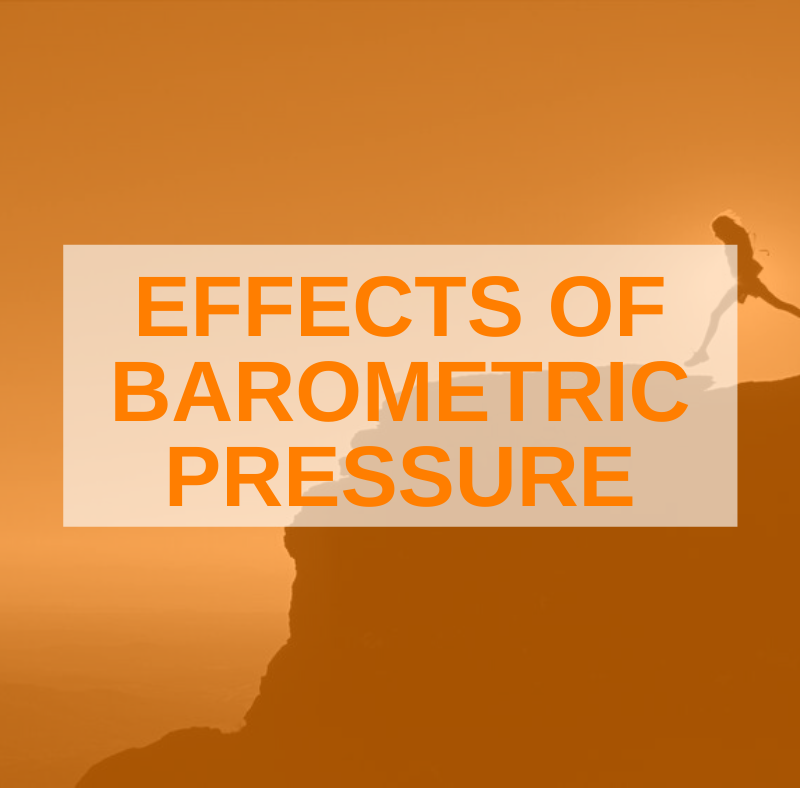
For years, athletes both recreational and professional have accepted the fact that running at higher elevations poses a unique challenge. The air density diminishes at high elevations, rendering the oxygen molecules necessary to fuel the lungs fewer in quantity. Understanding the effects of air pressure on pain and performance may help your clients adjust to and successfully overcome this barrier.
The Theory of Air Pressure on Pain Experience
At sea level, the air one breathes experiences a compression of 6000 more vertical feet of atmosphere than the air found in Colorado Springs, for example. This translates to a denser packing of oxygen molecules than what a runner would encounter at a higher elevation, and ultimately, more available oxygen.
Barometric pressure measures the weight of the surrounding atmosphere. Drops in barometric often herald the onset of storms or drastic changes in weather. Such lowered air pressure very often causes joint discomfort. By exerting less of a force upon the body, tissues around the joints can expand. Such expansion in turn applies pressure to the joints, very often eliciting pain.
However, the reverse proves true as well. Tissues that surround the knee joint resemble a balloon, with a finite capacity. Increasing atmospheric pressure in this case inhibits the expansion capability of these delicate tissues, thereby eliciting pain. Dr. David Hassinger, orthopedic surgeon and founder and CEO of Direct Orthopedic Care, offers an explanation for this phenomenon.
“Arthritis affects everything within the joint, including the lining and ligaments. All of those tissues have nerve endings that can feel changes in the weather, which may result in tightness, stiffness, and some discomfort.” For a competitive distance runner, this can potentially spell disaster…or at the very least, a potentially painful event.
Back in 2007, The Arthritis Foundation published the results of a study undertaken at Tufts University. Scientists determined that not only can lower barometric pressure cause joint pain; a plunge in air temperature yields the same results. Their data suggests that for every 10-degree drop in temperature, subjects observed an incremental increase in arthritis symptoms. When older adults claim to know in advance of an imminent weather pattern shift because “their knees hurt”, we should no longer scoff at or doubt their predictions.
The Veracity of the Correlation
Not every scientist agrees with the above data. The majority of studies attempting to quantify any pain-weather association pointed to arthritic subjects’ inclination to “assume” that their joint pain corresponded to weather changes. The fact that individuals living with other chronic pain issues (such as fibromyalgia or polymyalgia) typically find no link between their discomfort and pending storms substantiates this conclusion.
To test this theory, researchers Redelmeier and Tversky looked into whether or not the intensity of an individual’s pain truly corresponded to weather conditions. A self-assessment of pain showed no alignment between intensity and barometric pressure, nor temperature and/or humidity, for that matter. Once again, scientists found themselves reverting to the “assumption” theory. Perhaps dreary, cold and wet conditions correlate more directly with a dismal mood/outlook, during which normal pain might take on greater importance in a subjective brain.
Whether actual or assumed, an athlete experiencing acute pain typically delivers a poor performance. Understanding why this happens can confer a modicum of psychological comfort, although in the moment (or hours, for distance runners) that pain seems relentless. Coupled with the lessened amount of available oxygen, this double-pronged situation often appears overwhelming.
Altitude and the Distance Runner’s Experience
Clients preparing for a long-distance running event at a higher altitude can receive proper coaching to facilitate endurance and overall performance. Any sport highly aerobic in nature naturally requires a great deal of oxygen, not only for breathing but also to fuel muscular contractions. This process occurs as a result of oxidative metabolism. At any elevated altitude, defined as anywhere from 8,000 to 18,000+ feet above sea level, the decrease in available oxygen translates to inefficient oxidative metabolism, causing running performance to suffer.
Over 25 years ago, treadmill tests conducted by British researcher Mervyn Davies indicated that for every 1% increase in grade, even an elite runner’s pace slowed by ~3%. Such an incline accounts for 52.8 feet/mile. From this data, we can extrapolate that running time increases by 10 seconds/mile for those able to sustain a 5-minute mile. As one might expect, a 2% gradation doubles the effect (100 feet of climbing), 3% triples the length in running time, etc.
Short of relocating permanently to train in “thinner air”, a distance runner might choose to arrive at the site of the competition 3-4 weeks in advance. By completing his training in this new atmosphere, his body can adjust slowly. By the time of the event, the runner’s body can boast a red blood cell count increase. As a result, both mitochondrial and capillary densities also increase. All these factors contribute to a more comfortable and successful distance competition.
High Altitudes Favor Sprinters
As much as distance running can take a hit when in Colorado Springs, a sprinter thrives in such an atmosphere. Since the action of sprinting relies less on oxygen consumption/oxidative metabolism and more on the body’s ATP PC system, such a reduction in air resistance leads to faster runs.
The ATP-PC system consists of adenosine triphosphate (ATP) and phosphocreatine (PC). Immediate energy gets generated via a breakdown of stored high-energy phosphates; this system can manufacture ATP faster than any other in the human body. A properly fueled ATP-PC system can provide ample energy during maximal intensity, short-duration exercise (sprinting), lasting a good 10-15 seconds before fatigue sets in. We may liken this to a car’s V8 engine: its power does not last for the length of an extended car trip, but performs exceedingly well for one lap around a track.
In the Final Analysis
While many conditions, both weather-related and psychological, may contribute to less than stellar distance running, understanding and thereby properly preparing for high-altitude events and changes in air pressure can foster not only one’s performance but his emotional outlook as well.
References:
www.ncbi.nlm.nih.gov/pmc/articles/PMC6407773/
www.practicalpainmanagement.com/pain-weather-cloudy-issue
www.pnas.org/content/93/7/2895
pubmed.ncbi.nlm.nih.gov/12647091/
pubmed.ncbi.nlm.nih.gov/17037002/
www.brainlab.org/how-weather-impacts-knee-pain/
www.brainlab.org/wp-content/uploads/2014/03/Influence-of-Weather-on-Report-of-Pain.pdf
pubmed.ncbi.nlm.nih.gov/1608646/
www.trainerroad.com/forum/t/barometric-pressure-effect-on-performance/16746
co.milesplit.com/articles/70896/barometric-pressure-and-distance-performance
endurelite.com/blogs/free-nutrition-supplement-and-training-articles-for-runners-and-cyclists/how-altitude-affects-running-and-racing-performance
www.directorthocare.com/does-temperature-and-barometric-pressure-affect-joints/
www.runnersworld.com/advanced/a20820206/downhill-all-the-way/







